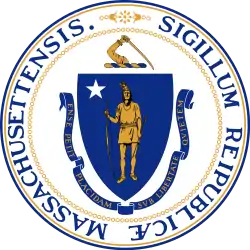M.P.M. Builders, LLC v. Dwyer
M.P.M. Builders, LLC v. Dwyer, 442 Mass. 87, 809 N.E.2d 1053 (2004), was a case decided by the Massachusetts Supreme Court that first adopted the Restatement Third of Servitudes for the relocation of easements in that state.[1]
| M.P.M. Builders, LLC v. Dwyer | |
|---|---|
 | |
| Court | Massachusetts Supreme Judicial Court |
| Full case name | M.P.M. Builders, LLC v. Dwyer |
| Decided | June 15, 2004 |
| Citation(s) | 442 Mass. 87; 809 N.E.2d 1053 |
| Court membership | |
| Judges sitting | Margaret H. Marshall, John M. Greaney, Roderick L. Ireland, Francis X. Spina, Judith A. Cowin, Martha B. Sosman, Robert J. Cordy |
| Case opinions | |
| Decision by | Cowin |
| Keywords | |
Factual background
Dwyer owned a dominant estate that had an easement across a parcel owned by M.P.M. Builders that connected to a public road at several points. M.P.M. wanted to develop the lots, but the easement ran through the planned development. M.P.M. proposed to relocate the easement and create new connections to the public road. Dwyer declined, and M.P.M. sought a declaratory judgment that they were allowed to unilaterally relocate the easement.
Decision
The lower Land Court ruled against M.P.M. The Massachusetts Supreme Court ruled that the Land Court correctly applied existing law, but that the standard for unilateral relocation of an easement by the owner of a servient estate in the Restatement Third of Servitudes was better suited to modern times. The Restatement allowed for unilateral relocation of the easement if it did not lessen the utility of the easement, increase the burdens on the owner of the easement, or frustrate the purpose of the easement. The court noted that this may often call for a hearing to determine what would constitute a reasonable relocation.[2]
References
- M.P.M. Builders, LLC v. Dwyer, 442 Mass. 87, 809 N.E.2d 1053 (2004).
- Casner, A.J. et al. Cases and Text on Property, Fifth Edition. Aspen Publishers, New York, NY: 2004, p. 929
External links
- Text of M.P.M. Builders, LLC v. Dwyer 442 Mass. 87, 809 N.E.2d 1053 (2004) is available from: Google Scholar Leagle
- Case Brief on LawSchoolCaseBriefs.net